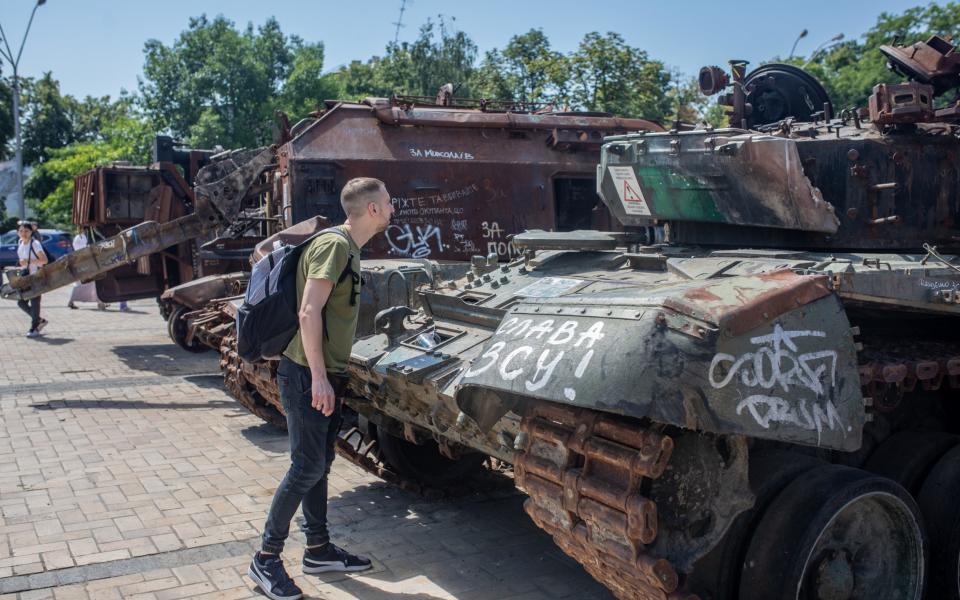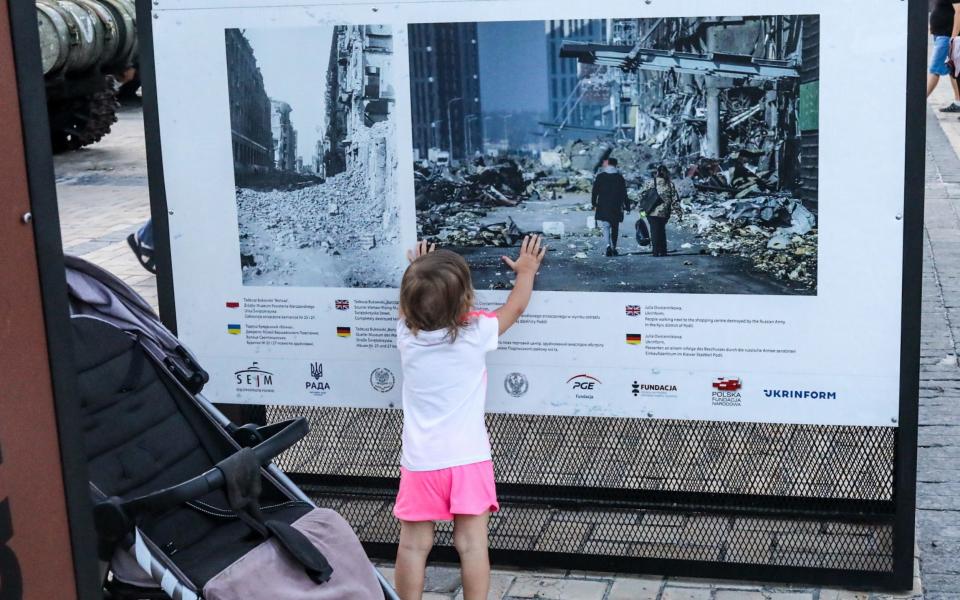In the spring of 2022, the Ukrainian city of Bucha fell victim to a brutal invasion by Russian forces. The first battle for the city, located on the eastern outskirts of Kiev, left 1,400 civilians dead. Moscow’s forces are still accused of committing a litany of war crimes during the months-long occupation that followed.
But now the ruined streets have become a summer holiday destination – at least for a certain group of tourists. Bucha has attracted visitors as a so-called “dark tourism” location, one of many places around the world that draw people for the tragic or sinister events that accompany them. Such attractions form a macabre global industry that is worth £25 billion by some estimates.
Today, at least a dozen companies offer tours of Bucha and Irpin, where at least 290 civilians were killed by Russian forces, and other previously occupied areas in Ukraine.
Curious visitors began arriving as soon as the areas were liberated from Russian control, it seems. “I was scared at first because I wasn’t sure what it would be like, and there were sirens and alarms every day,” said Stephan, 29, from Germany, who visited Bucha in August 2022, just five months after Russian troops withdrew from the city. “You only saw a few missiles intercepted by the air defenses, and you never knew what could happen.”

Stephan, who runs a YouTube channel called My Expat Diary, which features videos about his travels to Afghanistan and North Korea, as well as more typical holiday destinations like Japan, Greece and Europe, found his way to Bucha by finding locals in Kiev willing to drive him into the city and show him around. What he found surprised and bewildered him in equal measure.
“About 80 percent of them looked unharmed,” Stephan says.[But] I interviewed some people there about Russia’s atrocities, and it was really horrible. It was the most disturbing place I’ve ever seen in Ukraine. One man told me how his neighbor had been murdered.” He doesn’t consider himself a “dark tourist,” but he had a “personal interest” in seeing Bucha for himself after reading reports about the occupation from Colombia, where he was living when Russia invaded Ukraine in February 2022. “I also hoped to generate hits on YouTube and show others what it was like,” he says.


According to 33-year-old Ukrainian lawyer Dmytro Nykyforov, many people in the war-torn country, people like Stephan who want to experience the tragedies in Ukraine up close, avoid the world and the devastation wrought by Russia.
Originally from Oleshky, near Kherson, Nykyforov fled to Kiev as a refugee early in the war. He now runs tours in Bucha and Irpin, starting at around £215 per person, and says he is “delighted” to see others offering similar services online.
“I am one of many Ukrainians who have gotten used to the war, so I am not upset when we have tourists who want to see what is happening here,” Nykyforov explains. “The main idea is to share our experiences with them and help them learn more about the war,” he says.
War Tours, Nykyforov’s company, pays a wage to its guides – who are themselves refugees – and regularly donates money to the war effort. But some of its competitors appear to be raking in the cash: a week-long “war tour” package reportedly offered to tourists has a price tag of £3,000.
Most of Nykyforov’s clients come from the U.S., Britain or “small European countries,” he says, and interest in tours has increased this summer. “I think they deserve to see what’s happening here, because their governments support Ukraine and they pay for it with their taxes,” he says, adding that “people have a right to know how their money is being spent.”
It appears that the Ukrainian government is also keen to attract visitors. In March, the country announced a campaign to attract tourists, saying it had the infrastructure and hotels to welcome foreign travelers, albeit after the war ended. “All the money people spend in Ukraine will help the economy recover,” said tourism chief Mariana Oleskiv.
“Now the brand is Ukraine [is] developed and known all over the world, but it is not associated with tourism,” she added, imploring tourists to visit the areas of the country that remained uninhabited during the conflict and are “very beautiful.”


While Ukraine may not have the same reputation as neighbouring Hungary and Poland, which welcome millions of visitors each year to cities such as Warsaw, Krakow and Budapest, the country has been a hotspot for dark tourism for over a decade, following the decision to reopen the Chernobyl exclusion zone in 2011.
In 2021, more than 70,000 people visited the disaster-stricken area, up from nearly 125,000 in 2019, three years before the war broke out.
The site was abandoned after a massive nuclear disaster in 1986 and only reopened to the public when it was determined that radiation levels were safe enough for human exposure.
“There is a lot to see there if you follow the official route and don’t stray from the group,” Emergencies Ministry spokeswoman Yulia Yershova said at the time – “although it is a very sad story.”
By 2015, a handful of companies had sprung up to bus dark tourists from Kiev to Chernobyl, some 60 miles from the capital. Visitors were also given their own Geiger counters in exchange for a small fee.
At least one such company has now added Bucha and Irpin to its list: a site called Chernobyl Story offers a “de-occupied cities tour” of Hostomel, Irpin, Bucha and Romanivka for £140, along with private tours of Chernobyl for just over £600. Chernobyl Story donates “a percentage of the purchase price as a donation to orphanages,” according to the website.
Nykyforov emphasizes that visitors to the locations are not driven by morbid curiosity, but rather by the desire to see with their own eyes and unfiltered the devastation caused by the war.


“People are interested in Bucha because it is evidence of Russian aggression in their own eyes, rather than just through the media,” he explains. But “they also wanted to see destroyed Russian vehicles, and the different types of drones used by both sides, as well as the famous exhibits in Kiev.”
Like Nykyforov, refugee Maria Romanenko, 31, doesn’t think there’s a problem with “dark tourism” itself. “People have always been drawn to parts of the world that are suffering in that sense,” says Romanenko, who now lives in Manchester and runs walking tours of the city for other Ukrainians in Britain.
Her tours of Manchester include the site of the 1996 IRA bombing on Commercial Street, because “people are always interested in seeing an area recover”. But she also points out that “tour companies need to be controlled and monitored” to ensure “no one is making a profit” – a difficult task after two and a half years of fighting Moscow’s forces, she says.
Still, she is clear that the benefits of welcoming visitors – in the right places, with careful planning – outweigh the potential downsides. “The economy has suffered greatly over the past two and a half years,” Romanenko says. “The need for investment is very high, with large parts of the country in ruins from bombing and artillery fire.”
Beyond the devastation, she adds, Ukraine has much more to offer. “There are great restaurants that hardly get any visitors,” as well as shopping, historic cultural attractions and areas of immense natural beauty. Later this year, Romanenko will take a group of Britons from Manchester and London to Lviv, a major civic center in the west of the country that has been largely spared the worst of the Russian offensive.
Ultimately, however, “no area is completely safe, because you don’t know when and where exactly a bomb can hit,” Romanenko says. “I worry about such tours [near Kyiv]”, she adds. “It’s a huge responsibility to say come on, we’ll show you the area, while there are air raid sirens going off all the time.”